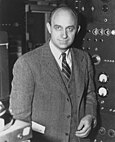Portal:Chicago/Selected biography/151
Enrico Fermi was an Italian theoretical and experimental physicist, best known for his work on the development of Chicago Pile-1, the first nuclear reactor, and for his contributions to the development of quantum theory, nuclear and particle physics, and statistical mechanics. Along with J. Robert Oppenheimer, he is referred to as "the father of the atomic bomb". He held several patents related to the use of nuclear power, and was awarded the 1938 Nobel Prize in Physics for his work on induced radioactivity and the discovery of transuranic elements. Throughout his life Fermi was widely regarded as one of the very few physicists who excelled both theoretically and experimentally. Fermi's first major contribution was to statistical mechanics. After Wolfgang Pauli announced his exclusion principle in 1925, Fermi followed with a paper in which he applied the principle to an ideal gas, employing a statistical formulation now known as Fermi–Dirac statistics. Today, particles that obey the exclusion principle are called "Fermions". Later Pauli postulated the existence of an invisible particle with no charge that was emitted at the same time an electron was emitted during beta decay in order to satisfy the law of conservation of energy. Fermi took up this idea, developing a model that incorporated the postulated particle, which Fermi named the "neutrino". His theory, later referred to as Fermi's interaction and still later as the theory of the weak interaction, described one of the four forces of nature. Through experiments inducing radioactivity with recently discovered neutrons, Fermi discovered that slow neutrons were more easily captured than fast ones, and developed a diffusion equation to describe this, which became known as the Fermi age equation. He bombarded thorium and uranium with slow neutrons, and concluded that he had created new elements, for which he was awarded the Nobel Prize, but the new elements were subsequently revealed to be fission products. Fermi left Italy in 1938 to escape racial laws that affected his Jewish wife Laura, and emigrated to the United States, where he worked on the Manhattan Project during World War II. Fermi led the team that designed and built the Chicago Pile-1, and initiated the first artificial self-sustaining nuclear chain reaction when it went critical on 2 December 1942. He was on hand when the X-10 Graphite Reactor at Oak Ridge, Tennessee, went critical in 1943, and the B Reactor at the Hanford Site went critical in 1944. At Los Alamos he headed F Division, where he worked on the thermonuclear "Super". He was present at the Trinity test on 16 July 1945, where he used one of his Fermi method experiments to estimate the bomb's yield. After the war, Fermi served on the influential General Advisory Committee of the Atomic Energy Commission, a scientific committee chaired by Robert Oppenheimer which advised the commission on nuclear matters and policy. Following the detonation of RDS-1 in August 1949, the first Soviet fission bomb, he wrote a strongly worded report for the committee, opposing the development of a hydrogen bomb on both moral and technical grounds. He was among the scientists who testified on Oppenheimer's behalf at the Oppenheimer security hearing in 1954 that resulted in denial of Oppenheimer's security clearance. Fermi did important work in particle physics, especially related to pions and muons, and he speculated that cosmic rays arose through material being accelerated by magnetic fields in interstellar space. Many awards, concepts, and institutions are named after Fermi, including the Enrico Fermi Award, the Enrico Fermi Institute, the Fermi National Accelerator Laboratory, the Fermi Gamma-ray Space Telescope, the Enrico Fermi Nuclear Generating Station, and the synthetic element fermium.

